Nissan's Rogue has been on the market for over a decade, with the very first examples wading into the hot compact crossover market in late 2007. Now in its second generation, the Rogue nameplate has steadily become one of America's best sellers, and is Nissan's top seller by a long shot. In 2018 alone, 412,110 buyers chose the Nissan Rogue over its two main rivals, the Honda CR-V and Toyota RAV4. We spent a week with a 2019 Nissan Rogue SL AWD to find out why nearly half a million people found a reason to park one in their driveway.
Disclosure: Nissan USA lent us this 2019 Rogue SL AWD for a week, and dropped it off with a full tank of gas.

Competitors:
Honda CR-V
Toyota RAV4
Subaru Forester
Mazda CX-5
Ford Escape
Kia Sportage
Volkswagen Tiguan
Hyundai Tucson
GMC Terrain
Chevrolet Equinox
Jeep Cherokee
Quick Specs:
Starting MSRP (excluding destination)
S FWD $25,020
S AWD $26,370
SV FWD $26,440
SV AWD $27,790
SV FWD Hybrid $27,700
SV AWD Hybrid $29,050
SL FWD $31,490
SL AWD $32,840*
SL FWD Hybrid $31,640
SL AWD Hybrid $32,990
*As tested price: $36,085.00
2.5L 4 cyl engine
170 horsepower
175 lb-ft torque
Continuously Variable Transmission (CVT)
P225/55R19 all-season tires
19” alloy wheels
Front/Rear Headroom (Inches): 39.5/36.6
Front/Rear Legroom (Inches): 43.0/37.9
Cargo volume rear seats up/down (Cu.Ft.): 39.3/70.0
Fuel Tank (Gals): 14.5
Fuel Economy (City/Highway/Combined): 25/32/27
NHTSA Overall Safety Rating: 4 Stars
The 2019 Nissan Rogue competes in a hotly contested segment full of compelling choices from every major OEM nameplate. The Rogue is a compact crossover, which is largely becoming a favored body style among consumers. This particular Rogue is outfitted with the SL trim level and carries an as-tested price of $36,085.00. It's essentially a fully loaded example, and comes with many features such as 19” alloy wheels, Intelligent Around View Monitor, power front seats, Android Auto/Apple CarPlay, heated steering wheel and front seats, and a bevy of tech including auto emergency braking, blind-spot warning, lane departure warning, rear auto braking, and Nissan’s driver assistance system - ProPILOT Assist - which includes adaptive cruise control and Steering Assist. The EPA’s rating for the AWD non-hybrid Nissan Rogue is 25 city, 32 highway, and 27 combined.
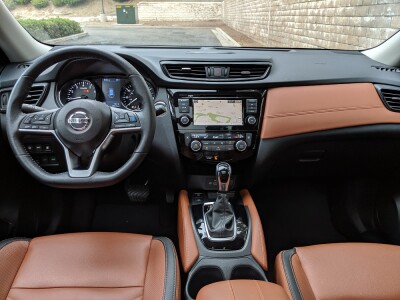
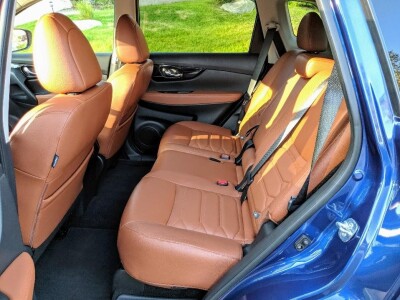
Upon its initial arrival, I was impressed by the quality and consistency of the Caspian Blue Metallic paint. It contrasted nicely with the optional Platinum Reserve quilted leather tan seats. Nissan’s “Zero Gravity Front Seats” are standard across all trim levels; they're long-haul comfortable, with no back issues to report after hours of commuting. That said, I did wish that the center inserts of the seats were perforated. Even with the AC on in 75-degree weather, I did feel my back was hot and sticking to the seatback. The sun shines more frequently here in Southern California, so even minor things like that will have an effect on overall comfort. The sliding sun visors are a welcome addition, allowing them to be positioned to block direct sunlight coming in from the B-pillar region. Speaking of sliding, I do wish the center console armrest slid forward, but the padding was comfortable and soft. The A-pillars are a little thicker than I'd prefer, and the blind spot warning light really should be in the mirror rather than wedged into the trim piece at the forward base of the windows. Overall, the cabin is commendably quiet, but some road noise filters in when driving over rough surfaces. It's certainly a nice place to spend 4 hours a day.


Rush hour traffic can inflict major driver fatigue; as a super commuter, driver assistance features play a vital role in keeping me sane on the infamous 405 freeway. Nissan’s solution is ProPILOT Assist, which is a suite of systems that can automate mundane driving tasks. It'll automatically keep pace with the car in front when driving on the highway - even all the way down to a complete stop when traffic backs up. The system can also keep you centered in your desired lane as long as you always keep your hands on the steering wheel. All of this information is shown to the driver via a color screen in between the analog tachometer and speedometer. The systems can operate independently of each other, too. For example, you can enable adaptive cruise control with or without steering assist. In stop-and-go traffic, I mostly kept the steering assist off and turned it back on during stretches of higher speeds. At lower speeds, the system was prone to cause the Rogue to ping-pong back and forth in my lane, and frequently made minor adjustments to keep it centered in the lane while crawling along with fellow commuters. Another nice feature is the ability for the system to bring the Rogue to a complete stop and bring it back up to speed without any input. If traffic is stopped for longer than a few seconds, I did have to hit the Resume button on the steering wheel or the accelerator pedal, but it wasn’t a big nuisance. The biggest gripe was when the sensors were tracking a vehicle directly in front and another driver cuts in front of you, the system doesn’t sense it until it is almost fully in the lane and will slam on the brakes. If Nissan can update its system to sense vehicles merging sooner, ProPILOT would function more smoothly and not create a brake-slamming chain reaction behind me.

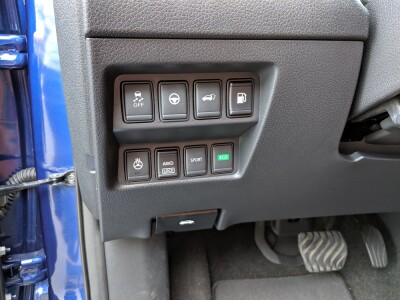
My daily commute consists of highway speed driving for approximately 15 miles, while the remaining time is spent in stop-and-go traffic. The Rogue seems designed with this type of use in mind, with emphasis placed on everyday comfort and usability over sporty driving characteristics. The highway ride is smooth and isolated, ironing out road unevenness and potholes. On the other hand, acceleration isn’t particularly impressive. With just 170 horsepower and 175 lb-ft of torque mated to a CVT, the power delivery is underwhelming. You really have to stomp on the go-pedal to try and pass slow-moving cars in the fast lane, or merging from an on-ramp. The relative lack of power would be more acceptable if the Rogue did better than our observed 23.9 MPG average. Other small nuisances center on wonky ergonomics; a slew of buttons are near your left knee, tucked way below the sightline and out of reach. They’re difficult to tell apart without taking your eyes off the road, so a degree of muscle memory is required. Some of these buttons, such as the heated steering wheel switch, Sport/Eco Modes, and Steering Assist would make more sense in a central location.
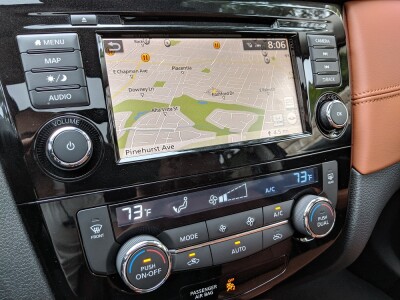
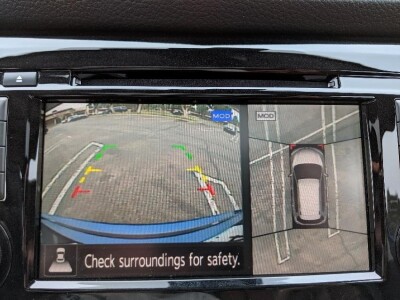
Infotainment systems are now a crucial component of any new car, especially as more consumers own a smartphone with Android Auto/Apple CarPlay capability. I was able to test out Android Auto using my Pixel 2 XL smartphone. Once you have the app installed on your phone, it’s as simple as plugging in via the USB port and tapping the icon on the Rogue’s 7-inch touch-screen display. I had no issues placing or receiving phone calls, using “Hey Google” voice prompts, entering an address on Google Maps, or playing music from Spotify. I do wish the screen was an inch or two larger, though. Thank you Tesla, RAM, and Volvo for showing how it's done. I’m glad Nissan kept the intuitive buttons and large knobs for volume and tuning. Nothing is faster than using physical buttons to access certain frequently-used commands. On the other hand, the video feed from rearview camera and around view monitor is grainy. I found myself relying more on the rear sonar while maneuvering in tight spots.

A feature that is often overlooked is the Tire Pressure Monitoring System (TPMS). As a commuter, a flat tire or low tire pressure can be a real pain when you are rushing out the door for work. If your tires are not properly inflated, the display can show you exactly which tire is low and what the PSI is. This can save you precious time instead of trying to figure out which tire is low by physically measuring each one. As any experienced commuter knows, properly inflated tires will result in better MPG. If your tires require inflation, Nissan includes another neat feature - when the correct PSI is reached, the Rogue will sound the horn and flash the emergency lights briefly to signal when to stop inflating. Such convenience features are much appreciated, and go a long way towards making the Rogue an excellent vehicle to live with every day.
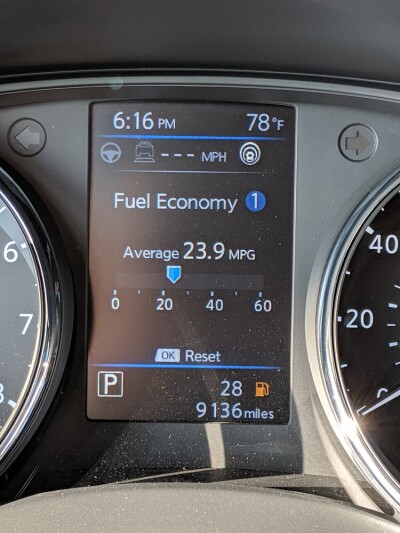
During its stay with us, the Nissan Rogue proved to be a pleasant place to be when stuck in traffic. I had no complaints with the seats, the auto AC worked as expected, and Nissan’s ProPILOT Assist worked well enough to be a valuable tool in reducing stress and fatigue while commuting. I wish the average MPG we observed was better, as its combined number didn’t ultimately match the EPA ratings. That said, your mileage may vary, and all internal combustion engines are inherently less efficient in stop-and-go traffic. The Rogue is a competent daily driver, as you get a lot of features for your hard-earned money. It's a great value proposition in this way; while it may not be the most exciting thing to take to work and for grocery runs, the agreeable road manners and time-saving convenience features help it stand out from the crowd. It's well worth a test drive if you are considering a compact crossover.





